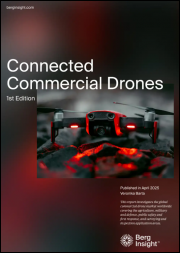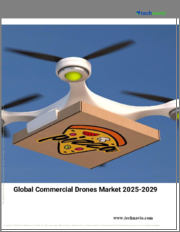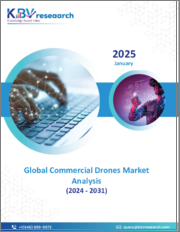
|
시장보고서
상품코드
1772169
세계의 스마트 상용 드론 시장 : 유형별, 자율 레벨별, 애플리케이션별, 최대 적재량별, 지역별, 기회, 예측(2018-2032년)Global Smart Commercial Drone Market Assessment, By Type (Fixed Wing, Multirotor, Hybrid), By Autonomy Level, By Application, By Payload Capability, By Region, Opportunities and Forecast, 2018-2032F |
||||||
세계의 스마트 상용 드론 시장은 예측 기간인 2025-2032년에 CAGR 11.43%를 기록하며, 2024년 114억 5,000만 달러에서 2032년에는 272억 2,000만 달러로 성장할 것으로 예측됩니다. 스마트 상용 드론 시장은 모든 유형의 용도에서 AI, IoT, 자율비행의 발전으로 인한 기회로 인해 빠르게 진화하고 있습니다. 스마트 드론은 실시간 데이터 수집, 모니터링, 효율적인 운영을 제공함으로써 산업을 변화시키고 있습니다. 스마트 드론은 다양한 지능형 센서를 탑재하고 머신러닝을 통해 자율적으로 작동을 지원하는 기능을 갖추고 있습니다. 드론은 복잡한 환경에서 탐색을 자동화하고, 특정 물체를 식별하고, 역동적인 상황에 적응할 수 있습니다. 농업 분야에서는 다중 스펙트럼 이미지는 작물의 건강과 수확량을 최적화하는 다차원적 시각을 제공합니다. 건설 분야에서 드론은 프로젝트 감독 및 안전 규정 준수에 도움이 될 수 있습니다. 드론 시장은 드론 분석 플랫폼에 대한 투자 증가뿐만 아니라 규제 및 업계 지원의 수용으로 인해 드론 시장은 분명히 혜택을 받고 있습니다. 스마트 드론은 기업과 전문가들이 업무 효율성을 높이고 비용을 절감하는 과정에서 비용 절감과 업무 개선을 실현할 수 있습니다. 스마트 드론의 응용과 발전이 업계에서 확대됨에 따라 스마트 상용 드론 시장은 기하급수적으로 성장하여 업계가 인사이트, 데이터를 도출하고 사람과 환경 간의 의사결정을 전달하는 방식을 변화시킬 것입니다.
예를 들어 2025년 6월, Unmanned Aerospace는 여러 산업 분야에 적용 가능하고, 무거운 페이로드를 운반하며, 연료 효율을 극대화할 수 있는 다양한 무인항공기 모델을 개발하기 시작했습니다. 해상 배송 솔루션을 실현하기 위해 미국 해군과 긴밀하게 협력하고 있습니다.
목차
제1장 프로젝트 범위와 정의
제2장 조사 방법
제3장 미국 관세의 영향
제4장 개요
제5장 고객의 소리
- 구입 결정시 고려되는 요소
- 경량 설계
- 배터리 적응성
- 항속거리 효율
제6장 세계의 스마트 상용 드론 시장 전망, 2018-2032년
- 시장 규모 분석과 예측
- 금액별
- 시장 점유율 분석과 예측
- 유형별
- 고정익
- 멀티로터
- 하이브리드
- 자율 레벨별
- 반자율
- 완전 자율
- 애플리케이션별
- 농업
- 배송 서비스
- 건설
- 감시
- 검사
- 기타
- 최대 적재량별
- 5kg 미만
- 5-25kg
- 25kg 초과
- 지역별
- 북미
- 유럽
- 아시아태평양
- 남미
- 중동 및 아프리카
- 기업별 시장 점유율 분석(상위 5사·기타 - 금액별, 2024년)
- 유형별
- 2024년 시장 맵 분석
- 유형별
- 자율 레벨별
- 애플리케이션별
- 최대 적재량별
- 지역별
제7장 북미의 스마트 상용 드론 시장 전망, 2018-2032년
- 시장 규모 분석과 예측
- 금액별
- 시장 점유율 분석과 예측
- 유형별
- 고정익
- 멀티로터
- 하이브리드
- 자율 레벨별
- 반자율
- 완전 자율
- 애플리케이션별
- 농업
- 배송 서비스
- 건설
- 감시
- 검사
- 기타
- 최대 적재량별
- 5kg 미만
- 5-25kg
- 25kg 초과
- 국가별 점유율
- 미국
- 캐나다
- 멕시코
- 유형별
- 국가별 시장 평가
- 미국의 스마트 상용 드론 시장 전망, 2018-2032년
- 시장 규모 분석과 예측
- 시장 점유율 분석과 예측
- 캐나다
- 멕시코
- 미국의 스마트 상용 드론 시장 전망, 2018-2032년
제8장 유럽의 스마트 상용 드론 시장 전망, 2018-2032년
- 독일
- 프랑스
- 이탈리아
- 영국
- 러시아
- 네덜란드
- 스페인
- 튀르키예
- 폴란드
제9장 아시아태평양의 스마트 상용 드론 시장 전망, 2018-2032년
- 인도
- 중국
- 일본
- 호주
- 베트남
- 한국
- 인도네시아
- 필리핀
제10장 남미의 스마트 상용 드론 시장 전망, 2018-2032년
- 브라질
- 아르헨티나
제11장 중동 및 아프리카의 스마트 상용 드론 시장 전망, 2018-2032년
- 사우디아라비아
- 아랍에미리트
- 남아프리카공화국
제12장 Porter's Five Forces 분석
제13장 PESTLE 분석
제14장 가격 분석
제15장 시장 역학
- 시장 성장 촉진요인
- 시장이 해결해야 할 과제
제16장 시장 동향과 발전
제17장 사례 연구
제18장 경쟁 구도
- 시장 리더 상위 5사의 경쟁 매트릭스
- TOP 5사의 SWOT 분석
- TOP 10 시장 기업의 주요 기업 상황
- SZ DJI Technology Co., Ltd.
- Parrot Drones SAS
- AeroVironment Inc.
- Skydio, Inc.
- Autel Robotics Inc.
- Yuneec International Co. Ltd.
- Teledyne FLIR LLC
- Insitu Inc.(Boeing)
- Wingcopter GmbH
- Zipline International Inc.
제19장 전략적 제안
제20장 조사회사 소개·면책사항
KSA 25.07.24Global smart commercial drone market is projected to witness a CAGR of 11.43% during the forecast period 2025-2032, growing from USD 11.45 billion in 2024 to USD 27.22 billion in 2032. The Smart Commercial Drone market is rapidly evolving with opportunities enabled by advances in AI, IoT, and autonomous navigation in all types of applications. Smart drones are changing industries by providing real time data collection, monitoring, and efficient operations. Smart drones have a variety of intelligent sensors and capabilities using machine learning to aid operations autonomously. Drones automate navigation in complex environments, identifying specified objects, and adapting to dynamic conditions. In agriculture, multispectral imaging provides multi-dimensional views which optimize crop health and yield. In construction, drones can help with project oversight and safety compliance. The market is clearly benefiting from regulatory and acceptance of industry support, as well as more investment being seen in drone analytics platforms. Smart drones provide cost savings and improved operations as companies and professionals continue to advance operational efficiencies and reduce costs. As applications and advancements with smart drones expand within industries, the Smart Commercial Drone market will grow exponentially, transforming how industries draw insights, data and convey decisions between people and their environment.
For instance, in June 2025, Unmanned Aerospace set out to create a different model of unmanned aircraft that can serve multiple industries, carry heavy payloads, and maximize fuel efficiency. Unmanned Aerospace continues to build on their existing models and is in close collaboration with the United States Navy to bring their delivery solutions to the sea.
Expanding Role of Smart Commercial Drones in Professional Workloads
Smart commercial drones are increasingly proving their value across multiple industries, changing how organizations are managing challenging workloads. With the capabilities of being equipped with advanced sensors, AI, and processing real-time data resulting in efficiency, these drones automate labor-intensive, repetitive and time-consuming processes to improve accuracy and help to manage increasingly complex operations. In agriculture, smart drones can monitor and deliver pesticide in the right amounts. In construction and infrastructure, smart drones are deployed aerial surveying and structural inspection processes to reduce risk and improve response time.
For instance, in June 2025, Walmart Inc significantly expanded its drone delivery operations in the United States, announced plans to serve around three million additional households through a partnership with drone operator Wing. Walmart began commercial drone deliveries in 2021 and has since completed more than 150,000 flights.
Strategic Industry Collaborations Fuel Market Expansion
Strategic partnerships are enabling smart commercial drone expansion by integrating expertise across industries. Drone manufacturers are working with AI specialists to improve autonomous capability, and with telecommunications providers to offer comprehensive connectivity for real-time operation. In industries, such as, agriculture, logistics, and infrastructure sectors, partners with industry leaders are driving innovative use cases catering to each industry's focus, from precision farming to automated inspections, while working together to connect regulatory partners with aviation authorities to validate aviation safety for the airspace system. Cross-industry partnerships are helping different sectors to overcome technological and operational limitations, resulting in an industry transformation for far-reaching adoption. As partnerships deepen, smart commercial drone technology will more rapidly facilitate digitization across sectors and industries and provide scalable and data-driven solutions to effectively drive efficiency and innovation.
For instance, in August 2024, AMSL Aero Pty Ltd, Borsight Inc., Grabba Technologies Pty Ltd signed contracts worth a total of USD 6.6 million in the next stage of the Sovereign Uncrewed Aerial Systems (UAS) challenge. Each company has signed a USD 2.2 million-dollar contract to finalize the development of their prototypes to a production standard and produce 100 general purpose UAS.
Semi-Autonomous Drones Emerge as Key Growth Engine for Smart Commercial Drone Market
Semi-autonomous drones provide the perfect intersection of AI automation with human oversight for commercialization. The fusion of advanced intelligent navigation systems with automation, obstacle detection, and workflows, including pilot control for safety and compliance purposes, set the stage for enterprises to adopt drone technology at scale. Semi-autonomy is versatile and valuable across many applications, such as agriculture, infrastructure inspection, and public safety, while enabling greater site efficiency without the intricacies of full autonomy. As manufacturers implement tighter integration of advanced edge computing and computer vision, semi-autonomous will become established as the new marketplace standard. They represent a low-risk- high-reward entry point into smart drone operations, and, as the highest potential growth area, they act as the crucial linking pin between regular manual piloting today and the initiatives directing to fully autonomous systems in the commercial drone space.
For instance, in January 2025, Ukrainian company Dron ZP unveiled an innovative semi-autonomous turret designed to neutralize enemy drones, particularly FPV (First-Person View) drones, which pose an increasing threat on modern battlefields. Tested by the Unmanned Systems Battalion of the 15th Brigade of the National Guard, this new weapon highlights Ukraine's continued efforts to integrate advanced technologies into its military operations to address the challenges of contemporary warfare.
North America Dominates the Smart Commercial Drone Market
North America has become the leader in the global smart commercial drone market due to favorable regulations, strong tech infrastructure, and fast adoption by the industry overall. The FAA's Part 107 rules provide operators with flexibility for commercial operations with minimal risk. In 2020, the FAA approved many BVLOS (beyond visual line of site) operations in key states to enable drone deliveries to scale across various sectors. Leading companies in the United States and Canadian commercial drone industry are leveraging drones for precision agriculture, inspecting energy infrastructure (as needed by the industry), and logistics solutions, while either investing in or being supported by fiber forward 5G infrastructure and integration with AI as part of the overall ecosystem. Recent events have showcased North America's tech innovation strength in Silicon Valley and provided a free flow of venture capital funding to many other regions to find more drone applications with commercial uses. North America has a strong opportunity to remain the highest function of or standards for commercial drone applications in worldwide markets.
For instance, in February 2025, The Defense Innovation Unit announced that it has selected 37 systems and components to add to its list of commercial drone capabilities certified for military use, pending final approvals to ensure they meet congressionally mandated cybersecurity and supply chain standards.
Impact of U.S. Tariffs on Global Smart Commercial Drone Market
Tariffs on components manufactured in China, such as sensors, batteries, and navigation systems, increased manufacturing costs
Production in China was common across the ecosystem, contributing to delays and sourcing of hardware and software.
Tariffs on some of the most popular drone and fleet products reached higher prices, significantly impacting retail prices.
Production is shifting to new countries, such as Vietnam, India, and Taiwan, to avoid tariff exposure.
Key Players Landscape and Outlook
The smart commercial drone industry is focused on innovation, with industry leaders and startups innovating autonomy and customizable solutions. Vertical integration dominates the marketplace, with providers offering combined drone hardware, AI analytics, and airspace management system software. Several niche players are now marketing applications for drone use, including agriculture, energy, and infrastructure expos. Collaboration with regulators is swiftly expanding operations like metropolitan drone delivery and beyond visual line-of-sight (BVLOS) flights. Sustainability is now a key focus for drone companies reflected in products that are quieter and energy efficient. The future appears to be autonomous drone swarming with a focus on fielder drone fleet operation, that depends on reliable, secure, compliant solutions that attend to technological and regulatory demands. Cooperative partnerships between drone developers and end-users will drive the nascent growth of commercial drone flights.
For instance, in June 2025, HP Additive Manufacturing Solutions focused on empowering drone manufacturers with high-quality polymer 3D printing, enabling them to quickly and reliably produce both prototypes and final parts. This technology allows drone makers of all sizes to achieve optimized performance, durability, and scalability throughout every stage of development.
Table of Contents
1. Project Scope and Definitions
2. Research Methodology
3. Impact of U.S. Tariffs
4. Executive Summary
5. Voice of Customers
- 5.1. Factors Considered in Purchase Decisions
- 5.1.1. Lightweight Design
- 5.1.2. Battery Adaptability
- 5.1.3. Range Efficiency
6. Global Smart Commercial Drone Market Outlook, 2018-2032F
- 6.1. Market Size Analysis & Forecast
- 6.1.1. By Value
- 6.2. Market Share Analysis & Forecast
- 6.2.1. By Type
- 6.2.1.1. Fixed Wing
- 6.2.1.2. Multirotor
- 6.2.1.3. Hybrid
- 6.2.2. By Autonomy Level
- 6.2.2.1. Semi-Autonomous
- 6.2.2.2. Fully Autonomous
- 6.2.3. By Application
- 6.2.3.1. Agriculture
- 6.2.3.2. Delivery Services
- 6.2.3.3. Construction
- 6.2.3.4. Surveillance
- 6.2.3.5. Inspection
- 6.2.3.6. Others
- 6.2.4. By Payload Capability
- 6.2.4.1. Under 5 kg
- 6.2.4.2. 5-25 kg
- 6.2.4.3. 25 kg+
- 6.2.5. By Region
- 6.2.5.1. North America
- 6.2.5.2. Europe
- 6.2.5.3. Asia-Pacific
- 6.2.5.4. South America
- 6.2.5.5. Middle East and Africa
- 6.2.6. By Company Market Share Analysis (Top 5 Companies and Others - By Value, 2024)
- 6.2.1. By Type
- 6.3. Market Map Analysis, 2024
- 6.3.1. By Type
- 6.3.2. By Autonomy Level
- 6.3.3. By Application
- 6.3.4. By Payload Capability
- 6.3.5. By Region
7. North America Smart Commercial Drone Market Outlook, 2018-2032F
- 7.1. Market Size Analysis & Forecast
- 7.1.1. By Value
- 7.2. Market Share Analysis & Forecast
- 7.2.1. By Type
- 7.2.1.1. Fixed Wing
- 7.2.1.2. Multirotor
- 7.2.1.3. Hybrid
- 7.2.2. By Autonomy Level
- 7.2.2.1. Semi-Autonomous
- 7.2.2.2. Fully Autonomous
- 7.2.3. By Application
- 7.2.3.1. Agriculture
- 7.2.3.2. Delivery Services
- 7.2.3.3. Construction
- 7.2.3.4. Surveillance
- 7.2.3.5. Inspection
- 7.2.3.6. Others
- 7.2.4. By Payload Capability
- 7.2.4.1. Under 5 kg
- 7.2.4.2. 5-25 kg
- 7.2.4.3. 25 kg+
- 7.2.5. By Country Share
- 7.2.5.1. United States
- 7.2.5.2. Canada
- 7.2.5.3. Mexico
- 7.2.1. By Type
- 7.3. Country Market Assessment
- 7.3.1. United States Smart Commercial Drone Market Outlook, 2018-2032F*
- 7.3.1.1. Market Size Analysis & Forecast
- 7.3.1.1.1. By Value
- 7.3.1.2. Market Share Analysis & Forecast
- 7.3.1.2.1. By Type
- 7.3.1.2.1.1. Fixed Wing
- 7.3.1.2.1.2. Multirotor
- 7.3.1.2.1.3. Hybrid
- 7.3.1.2.2. By Autonomy Level
- 7.3.1.2.2.1. Semi-Autonomous
- 7.3.1.2.2.2. Fully Autonomous
- 7.3.1.2.3. By Application
- 7.3.1.2.3.1. Agriculture
- 7.3.1.2.3.2. Delivery Services
- 7.3.1.2.3.3. Construction
- 7.3.1.2.3.4. Surveillance
- 7.3.1.2.3.5. Inspection
- 7.3.1.2.3.6. Others
- 7.3.1.2.4. By Payload Capability
- 7.3.1.2.4.1. Under 5 kg
- 7.3.1.2.4.2. 5-25 kg
- 7.3.1.2.4.3. 25 kg+
- 7.3.1.2.1. By Type
- 7.3.1.1. Market Size Analysis & Forecast
- 7.3.2. Canada
- 7.3.3. Mexico
- 7.3.1. United States Smart Commercial Drone Market Outlook, 2018-2032F*
All segments will be provided for all regions and countries covered
8. Europe Smart Commercial Drone Market Outlook, 2018-2032F
- 8.1. Germany
- 8.2. France
- 8.3. Italy
- 8.4. United Kingdom
- 8.5. Russia
- 8.6. Netherlands
- 8.7. Spain
- 8.8. Turkey
- 8.9. Poland
9. Asia-Pacific Smart Commercial Drone Market Outlook, 2018-2032F
- 9.1. India
- 9.2. China
- 9.3. Japan
- 9.4. Australia
- 9.5. Vietnam
- 9.6. South Korea
- 9.7. Indonesia
- 9.8. Philippines
10. South America Smart Commercial Drone Market Outlook, 2018-2032F
- 10.1. Brazil
- 10.2. Argentina
11. Middle East and Africa Smart Commercial Drone Market Outlook, 2018-2032F
- 11.1. Saudi Arabia
- 11.2. UAE
- 11.3. South Africa
12. Porter's Five Forces Analysis
13. PESTLE Analysis
14. Pricing Analysis
15. Market Dynamics
- 15.1. Market Drivers
- 15.2. Market Challenges
16. Market Trends and Developments
17. Case Studies
18. Competitive Landscape
- 18.1. Competition Matrix of Top 5 Market Leaders
- 18.2. SWOT Analysis for Top 5 Players
- 18.3. Key Players Landscape for Top 10 Market Players
- 18.3.1. SZ DJI Technology Co., Ltd.
- 18.3.1.1. Company Details
- 18.3.1.2. Key Management Personnel
- 18.3.1.3. Key Products Offered
- 18.3.1.4. Key Financials (As Reported)
- 18.3.1.5. Key Market Focus and Geographical Presence
- 18.3.1.6. Recent Developments/Collaborations/Partnerships/Mergers and Acquisitions
- 18.3.2. Parrot Drones SAS
- 18.3.3. AeroVironment Inc.
- 18.3.4. Skydio, Inc.
- 18.3.5. Autel Robotics Inc.
- 18.3.6. Yuneec International Co. Ltd.
- 18.3.7. Teledyne FLIR LLC
- 18.3.8. Insitu Inc. (Boeing)
- 18.3.9. Wingcopter GmbH
- 18.3.10. Zipline International Inc.
- 18.3.1. SZ DJI Technology Co., Ltd.
Companies mentioned above DO NOT hold any order as per market share and can be changed as per information available during research work.



















